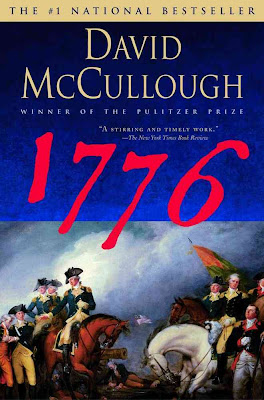Overview:
This handsome new version of McCullough's blockbuster (2.6 million copies of the original edition in print) is a visual feast. The text is abridged, but McCullough illustrates his riveting account of "the most important year in the war that made America" with maps, portraits and reproductions of broadsides and newspaper ads. Many famous paintings are included-Washington Crossing the Delaware (which, McCullough notes, captures the drama of the moment, even though many of the details are inaccurate); Charles Wilson Peale's portraits of Alexander Hamilton and Gen. Nathanael Greene; John Singleton Copley's portrait of Mercy Otis Warren, who wrote an early history of the revolution. McCullough also introduces less well-known images, such as a satiric print poking fun at the British prime minister, Lord North. Scattered throughout are vellum envelopes that hold facsimile reproductions of 37 primary sources-letters from George Washington to Martha, an ambrotype of Continental soldier Ralph Farnham as a centenarian, the text of a vow of allegiance to the king taken by Loyalists in New Jersey. By including these documents, McCullough has recreated not just the excitement of 1776, but the thrill of an archival research trip as well. From start to finish, this volume is a delight.
In this masterful book, David McCullough tells the intensely human story of those who marched with General George Washington in the year of the Declaration of Independence -- when the whole American cause was riding on their success, without which all hope for independence would have been dashed and the noble ideals of the Declaration would have amounted to little more than words on paper.
Based on extensive research in both American and British archives, 1776 is a powerful drama written with extraordinary narrative vitality. It is the story of Americans in the ranks, men of every shape, size, and color, farmers, schoolteachers, shoemakers, no-accounts, and mere boys turned soldiers. And it is the story of the King's men, the British commander, William Howe, and his highly disciplined redcoats who looked on their rebel foes with contempt and fought with a valor too little known.
At the center of the drama, with Washington, are two young American patriots, who, at first, knew no more of war than what they had read in books -- Nathanael Greene, a Quaker who was made a general at thirty-three, and Henry Knox, a twenty-five-year-old bookseller who had the preposterous idea of hauling the guns of Fort Ticonderoga overland to Boston in the dead of winter.
But it is the American commander-in-chief who stands foremost -- Washington, who had never before led an army in battle. Written as a companion work to his celebrated biography of John Adams, David McCullough's 1776 is another landmark in the literature of American history.
ENJOYYYYYYYYYYYYYYYYYYYYYYYYYYYYYYYYYYYYYYYYYYYY!
And Blessed Are The Ones Who Care For Their Fellow Men!


No comments:
Post a Comment